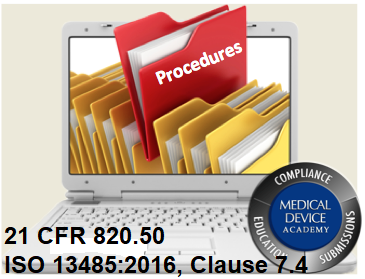This article reviews how to audit your labeling process for 21 CFR 820 compliance with the six requirements of section 820.120.
 The most common cause of recalls is labeling errors. Therefore, one of the best ways to avoid a recall is to perform a thorough audit of your labeling process. Unfortunately, most auditors receive no specific training related to labeling. The primary reason for the lack of labeling-specific training is because most auditor training focuses on ISO certification requirements.
The most common cause of recalls is labeling errors. Therefore, one of the best ways to avoid a recall is to perform a thorough audit of your labeling process. Unfortunately, most auditors receive no specific training related to labeling. The primary reason for the lack of labeling-specific training is because most auditor training focuses on ISO certification requirements.
ISO 13485 Requirements for the Labeling Process
ISO 13485 only requires the following labeling requirements: “The organization shall plan and carry out production and service provision under controlled conditions. Controlled conditions shall include, as applicable…g) the implementation of defined operations for labeling and packaging.” ISO 14969 is the guidance document for ISO 13485, and the guidance includes additional recommendations for control of the labeling process to prevent errors. Unfortunately, auditors are trained to audit for compliance with regulations, while guidance documents are neglected almost entirely. ISO labeling requirements are vague. Therefore, auditors need to focus on the six requirements of 21 CFR 820.120–the section of the FDA QSR specific to labeling.  Most auditors are taught to develop a regulatory checklist to verify requirements. However, the process approach to auditing is a more effective approach to identify ways that the labeling process can break down. Below examples of how the two approaches differ are provided for each of the six requirements:
Most auditors are taught to develop a regulatory checklist to verify requirements. However, the process approach to auditing is a more effective approach to identify ways that the labeling process can break down. Below examples of how the two approaches differ are provided for each of the six requirements:
1. Labeling Procedure
Most auditors, and FDA inspectors, request a copy of a labeling procedure to verify compliance with the first requirement. In their notes, they record the document number and revision of the procedure. The auditor may also review the procedure to ensure that the procedure includes each of the other five regulatory requirements listed below. The process approach to auditing also verifies compliance with the requirement for a procedure. Still, auditors using the process approach ask the process owner to describe the process, and the process description provided is compared with the procedure.
I also teach auditors to ask the process owner to identify where in the procedure, each requirement can be found. This eliminates the need to spend valuable audit time reviewing a procedure and forces the process owner to demonstrate their familiarity with the procedure.
2. Label Integrity
A lack of labeling integrity is seldom raised as an observation by auditors, unless labels are falling off of the product, or if the label content is illegible. During hundreds of audits, I have never noticed a label falling off the product, but I have seen customer complaints about labels falling off. Another way to assess if there is a problem with labeling integrity is to ask how the labeling specifications were established, verified, and validated. The user environment is frequently the determining factor for labeling specifications. For example,
- Does the label need to be waterproof?
- Is the print likely to be exposed to abrasion that could rub off the ink?
- Are the storage conditions likely to include high heat and humidity that could cause the adhesive to fail?
This type of approach links the labeling of products to customer focus and design inputs.
3. Labeling Process Inspection
The inspection of labeling is more than a visual examination. A thorough inspection requires a systematic review of the label content to ensure that the label information matches the requirements for the specific production lot. The requirements specify verification of:
- correct expiration date
- control number
- storage instructions
- handling instructions
There is also a requirement to document the date of inspection and the person that performed the inspection. An auditor can verify that the labeling inspection is being performed by reviewing records of the inspection, but you will rarely find an inspection record where the label is nonconforming. If you follow the process, you might ask the process owner where nonconforming labeling is recorded. The nonconforming material records should be an output of every inspection process. Auditors should also ask for metrics regarding a process. The frequency of labeling mix-ups and labeling errors identified during an inspection is an important metric that can be used as an indicator of weaknesses in labeling operations.
4. Labeling Storage
Most auditors will verify that labels are stored in a location to prevent deterioration or damage, but the highest risk is the mix-up of labels. Therefore, it is crucial to control the location of labels so that the incorrect labels cannot be accidentally distributed to the wrong manufacturing line.
In 21 CFR 820.150, there is also a requirement to establish “procedures that describe the methods for authorizing receipt from and dispatch to storage areas and stock rooms.” Therefore, as an auditor, you might consider asking the process owner what the input to the labeling distribution process is (e.g., a work order) and which distribution records are created during the process. A labeling requisition and/or “pick list” from production planning is often used as an input to the labeling process, while the distribution of labeling to manufacturing usually requires a log entry for distribution from a stockroom, or assignment of a lot number to the batch of labels that must be entered in a log.
5. Labeling Process
It is insufficient to review DHRs for the labeling process. When you interview the process owner, you should determine who is responsible for creating and inspecting labels. Then, I coach auditors to go and view labeling operations at the source. By interviewing operators and asking them to demonstrate entry of variable data for labels and printing of labels, you can answer each of the following questions without even asking:
- Is validated software is being used?
- Are label templates protected from inadvertent changes?
- How do operators ensure that labels from different lots are not mixed up?
Interviewing inspectors can determine if calibrated tools are being used to verify labeling dimensions and the proper placement of labels. You should also observe how inspectors ensure that variable data is correct.
6. Control Number
Most auditors will sample DHR records to verify that lot control numbers are recorded for each batch of products. However, when an auditor is focusing on records, the auditor is unlikely to identify any aspects of label handling that could result in mix-ups. To ensure that processing and segregation of different lots are adequate, an auditor has to observe line clearance procedures and to verify that each lot of labels is identified with regard to the lot number, quantity, and the released status if the identification information about the label is separated from the physical labels, the potential for labeling mix-ups increases.
One final aspect of labeling and control numbers to consider is the impact of new UDI regulations. Labeling will need to indicate the date of manufacture and expiration of the product. This information needs to be incorporated into the variable content of labels. Therefore, if labels are pre-printed, it may be necessary to reprint labels when the date of manufacture changes. This additional requirement is likely to force companies into on-demand printing of labels and automated software control systems. Auditors can verify the successful implementation of labeling process changes by auditing for compliance with the revised procedures.
UDI states that production identifiers (PI) consist of Manufacturing Date, Expiration Date, Lot/Batch Number, Serial Number. The rule also states that if a labeler does not use any of the listed PI, they do not need to have it on their labels. This will most likely apply to Class I device labelers only as Class II, and III labelers usually have one or more of the PI on their labels. Due to the variable nature of the PI, many labelers are adding in-line label verifiers to make sure their labels are readable by scanners.















